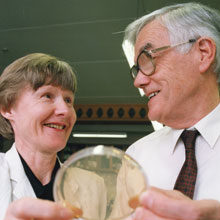Obituary: Professor Sir Kenneth Murray (1930–2013)
Issue: Biogeography
27 August 2013 article

Professor SIR Ken Murray FRS, FRSE, BSc, PhD (Birmingham) (30 December 1930–7 April 2013) was an eminent scientist who developed some of the earliest methods for genetic engineering. He used these to produce the first effective vaccine against hepatitis B virus, which has saved countless lives worldwide.
Ken Murray was born in Yorkshire and brought up in the Midlands. He left school at 16 to join Boots in Nottingham as a laboratory technician, where his potential was recognised and he was persuaded to study part-time for a degree. He obtained a first-class honours degree in chemistry and then a PhD in microbiology from the University of Birmingham. It was in Birmingham that he met Noreen, who was to become a lifelong scientific colleague as well as his wife.
After working at Stanford University and the MRC Laboratory of Molecular Biology, Ken joined the University of Edinburgh in 1967. His scientific interests lay in methods for analysing and manipulating DNA. Along with Noreen and others, he helped develop recombinant DNA technology, and immediately put these methods to use – in developing a vaccine for a potentially fatal liver disease, hepatitis B. There was no reliable treatment and around 300 million people were infected with the virus. Ken found a way to identify the hepatitis B virus and then produced a recombinant vaccine.
This was done under difficult conditions, as people were apprehensive of new genetic engineering technology. By 1978, Ken and colleagues had created the vaccine and later proved that it was effective in treating hepatitis B. He was involved in the establishment of Biogen, the first European-based biotechnology company, which successfully commercialised the vaccine. Using the income from licensing the vaccine, Ken founded the Darwin Trust of Edinburgh in 1983. The Trust has supported the education of many early-career scientists, and helped to fund research and facilities at the University of Edinburgh. Ken had always taken an interest in science education, and he funded outreach activities to help inspire schoolchildren to be interested in science.
Ken received many honours for his outstanding work. He was elected to the Royal Society in 1979, received the Willem Meindart de Hoop Prize in 1983, and a Saltire Society Scientific Award in 1992. He was knighted in 1993, and awarded two Royal Medals – one by the Royal Society of Edinburgh in 2000 and one by the Royal Society in 2012.
The new science and engineering library at the University of Edinburgh has been named the Noreen and Kenneth Murray Library, in recognition of the couple’s scientific success and their support for science and engineering. It was typical of Ken that he was reluctant that the library should be named after them, but, having been persuaded, he insisted that Noreen’s name should be first. Despite Ken’s many scientific successes and his personal wealth through the licensing of the hepatitis B vaccine, he remained a very modest and approachable person. He thought that teaching was an important activity for an academic researcher, and was himself an inspirational teacher. He was very supportive of colleagues and quick to praise success.
Although Ken suffered ill health in later years, he remained intellectually very active. Noreen predeceased him in 2011. There is a wide community of people who consider themselves privileged to have known them, and many other people who did not know Ken, but whose research has been possible through science he developed, or whose education he financed, or whose lives have been immeasurably improved because of his vaccine work.
This obituary is based on one originally written by Professor Mary Bownes OBE FRSE, Senior Vice-Principal, The University of Edinburgh.
Image: Noreen and Ken Murray. Jonathan Littlejohn, Edinburgh..
